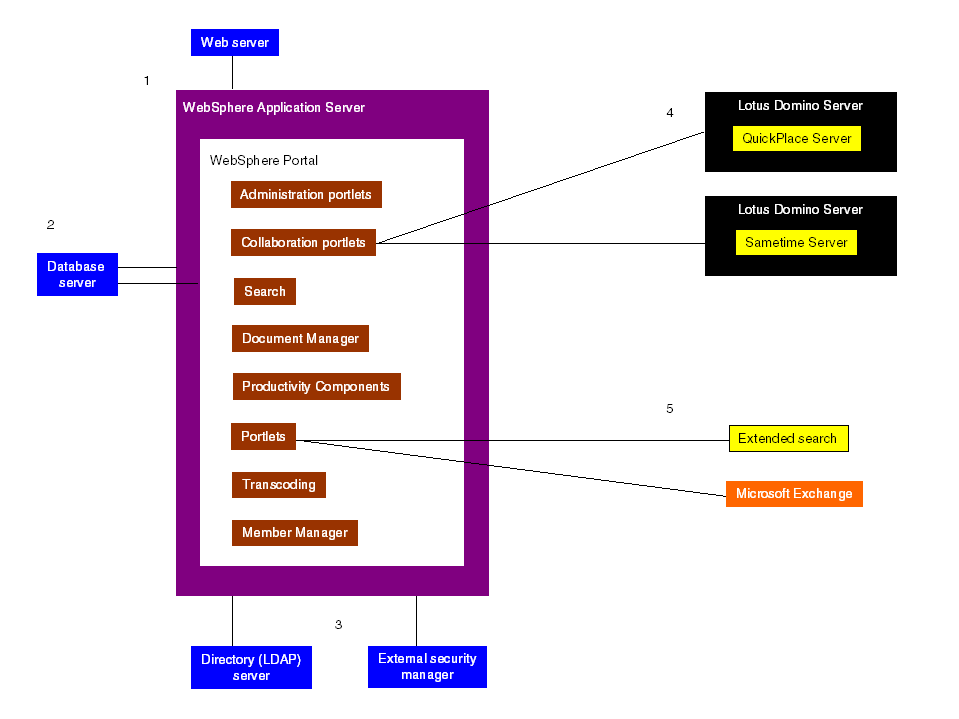Software and hardware topologies
Contents
Software topology
WebSphere Portal installs and runs as an application server on the WAS platform. For each installation of portal, an installation of WAS is required, and both the portal and WAS installations must reside on the same machine. Note that multiple portal instances on a single WAS instance on iSeries is supported.
HTTP is used as the transport protocol for portal requests. By default, WebSphere Portal uses the the internal HTTP transport within WAS to handle these requests. You can optionally configure an external Web server, such as IBM HTTP Server, to work with WebSphere Portal.
Because portal administration and configuration are dependent on WebSphere Application Server, you might have to use the administrative tools that are provided with WAS to monitor or control activities that are related to the portal. Additionally, if you configure an external Web server for use with the portal, you might need to use the Web server interface to administer portal-related activities.
A database subsystem is required for WebSphere Portal. By default, WebSphere Portal uses DB2 to store information about user identities, credentials, and permissions for accessing portal resources. Additionally, WebSphere Portal and WebSphere Application Server require access to a user registry. The following list provides different sources that the portal can use to access a user registry:
- LDAP directory, such as IBM Directory Server, IBM Secureway, Domino Directory, Active Directory, Novell eDirectory, or Sun ONE
- Custom user registry
- MemberRepository (Member Manager)
Portlets are key to the portal experience, and WebSphere Portal has built-in portlets that interface with tooling that extends portal functionality. The Lotus products, such as QuickPlace and Sametime, are used with WebSphere Portal to provide collaborative features. Portlets are also provided to integrate with extended search capabilities.
The software topology of WebSphere Portal and its
prerequisite software are shown in the following figure.

- WebSphere Portal installs and runs
as an application server on the WAS
platform.
Additional components components include:
- Administration portlets
- Collaboration portlets
- Search engine
- Document Manager
- Productivity Components
- Portlets
- Transcoding
- Member Manager
- A database is required to store WebSphere Portal configuration data.
-
An LDAP source can be used
for authentication and
authorization within the portal. The authentication component
is responsible for authenticating users at login.
The authentication component checks whether the credentials
that a user provided match with the assumed identity.
If the credentials are verified successfully, the user is
logged in and a session is established.
Also, an external security manager can be used for authentication.
In addition, the authorization component is the single access control decision point within the portal. It controls access to all sensitive portal resources, like for example compositions or portlets.
- Portlets talk to Lotus collaborative products.
- Portlets talk to additional software.
Hardware topology examples
WAS supports a wide variety of ways to deploy the portal in the computing environment. Commonly used topologies fall into one of the following broad categories.
- Single-machine topology. The components are installed on the same machine.
- Multimachine topologies. The components (the Web server, application server, databases, and so forth) are physically separated onto different machines.
- Vertical scaling topologies. Additional WebSphere Portal processes are created on a single physical machine through vertical cloning.
- HTTP server separation topologies. The Web (HTTP) server is located on a different physical machine than WAS and WebSphere Portal.
- Demilitarized zone (DMZ) topologies. Firewalls can be used to create demilitarized zones -- machines that are isolated from both the public Internet and other machines in the configuration. This improves portal security, especially for sensitive back-end resources such as databases.
It is important to remember that, in any topology, many resources and settings that are defined within WAS, like Global Security Settings, DataSources, and so on, are shared across all applications, including the portal instance.
See also